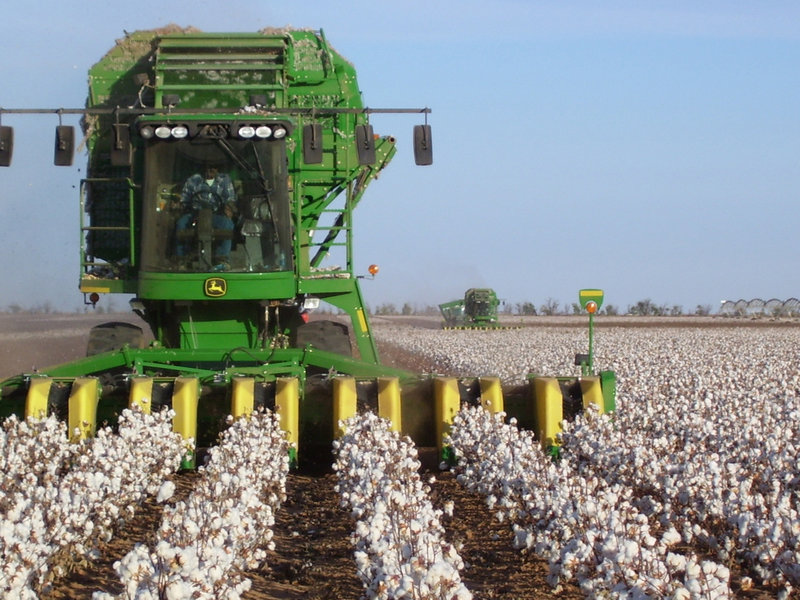Texas cotton grower Brad Heffington speaks Wall Street’s language of hedges, correlation charts and the like as easily as he discusses weevils and pesticides. Yet today his financial knowledge is of limited use.
Heffington’s been sidelined from the cotton futures market, thanks to a surge of financial speculators into the market, which originally was designed to protect farmers like him against price shifts.
“It’s something I watch but can’t use anymore,” Heffington said of the cotton futures market, where contracts for future delivery of 50,000 pounds of cotton are bought and sold.
Today, pension funds and Wall Street banks are pouring money into futures markets for cotton, oil, natural gas, wheat, coffee and other commodities. Such financial speculation helped drive an overheated cotton market to record levels of $2.17 a pound on March 7. Before peaking, cotton prices had risen by more than 140 percent in less than 18 months.
Some analysts contend that this speculative money from investors who will never actually take delivery of cotton is distorting the futures market, driving up cotton prices, and thus raising prices for apparel retailers and consumers alike. The United States is the world’s top exporter of raw cotton, sending much of it to Asia for garment manufacturing.
In a series of investigations this year, McClatchy Newspapers has reported how excessive financial speculation in commodities markets by companies with no intent of taking delivery of a product have punished consumers of gasoline and aviation fuel while doubling the price of coffee, all while there were no actual shortages in supplies.
The latest McClatchy Newspapers probe finds that increased volatility in cotton prices has corresponded with the changing composition of the futures market, where speculators hold more contracts than do growers, producers, buyers and users of commodities.
“What happens is the markets become unreliable and therefore unusable for them,” said Bart Chilton, a commissioner on the Commodity Futures Trade Commission, which regulates the futures markets. “It’s the same thing with cotton, same in energy. If you look at the volatility in the markets, there are not many of them that have sort of been stable.”
Sifting through CFTC historical data, McClatchy Newspapers found that the total number of outstanding futures contracts grew by about 80 percent from 1990 to 2010. That’s big growth in a historically small market.
Moreover, the number of contracts doubled between 2004 and 2010. This parallels the timeframe when institutional investors began to play seriously in commodity markets, aided by popular commodity indices developed by investment bank Goldman Sachs and the now-disgraced financial giant American International Group.
For much of the past two decades, Wall Street banks and other big financial firms’ activities in the futures markets were hidden in the data. Prior to September 2009, they were listed as if they were a grower or buyer of cotton, since they were hedging private bets they’d made on cotton, just like growers and buyers who deal in the actual goods. It was hard to tell what portion of the overall market the speculators represented.
That changed after the first week of September 2009, when the CFTC began providing data that separated out futures contracts held by swap dealers — financial players betting on cotton but not producing, processing, merchandising or using it. The agency also began reporting contracts held by money managers — big pension funds and the like that trade cotton contracts on behalf of pensioners or investors.
For much of the prior 20 years, the data showed commercial players, presumably growers and buyers, accounted for roughly 70 percent to 75 percent of cotton trading. That’s in line with historical trends for crude oil and other commodities, where speculators had until recent years accounted for only about a quarter of all futures contracts held.
But on the first week of the broader reporting, the data shows that financial speculators actually had 61 percent of all cotton contracts. Since then, the percentage has come down to the 50 percent range, but it’s still high by historical standards.
That’s where farmer Heffington comes back into the story. He’s a savvy grower who used to augment income from farming in the Lubbock area with well-placed bets in the futures market.
“You can’t afford to hedge your costs in the market like you used to. I don’t know what the answer is. This is a big problem,” he said. “In the last few years, that’s really become futile. It’s just not working right now for us.”
The wild gyrations in the price of cotton are also claiming other victims.
Retailers such as Macy’s, Ralph Lauren and Levi Strauss&Co. all have said in recent earnings reports that they’re unable to pass along fully to consumers their rising cotton prices, and they have seen profits slip.
“The pricing issue, because of cotton, is a unique issue to this timeframe,” Blake Jorgensen, Levi’s chief financial officer, said during an Oct. 11 earnings call with investment analysts. He warned that volatile cotton prices would continue to cloud earnings forecasts.
Cotton futures prices have tumbled since the March peak, settling around $1 per pound in recent weeks, down about 55 percent. Both growers and buyers complain that it’s hard to run a business when cotton prices oscillate so wildly month to month, week to week, even within a day.
“The volatility has been maybe the bigger concern — going up so high, and then coming back down. That is one of the things that has caused much uncertainty,” said Gary Adams, vice president of economics and policy analysis for the National Cotton Council of America. “I think a lot of them can adjust more easily to the price level if they have some comfort of knowledge that prices are going to stay at that level.”
The rise in commodity prices couldn’t happen without some underpinning in growing demand from big developing nations such as China and Brazil, which both host a rapidly expanding middle class.
But there are other complicating factors.
One is the rise of index-fund investment, where pension funds and other big institutional investors began viewing commodities as an asset class that often moved in the opposite direction of stocks. Toward the middle of the last decade, these funds began spreading a large amount of money across a range of commodities, from cotton and coffee to oil and natural gas.
They took buy-and-hold strategies, rolling over their holdings as contracts expired as if they were holding a stock that they believed would increase in value over time. Their expectation is that global growth over time will pull up demand for these raw materials and food products.
Futures markets, however, aren’t designed to operate like the stock market. Instead, they’re supposed to help buyers and sellers find an equilibrium price. That’s why Heffington and others favor forcing speculators to take actual possession of some cotton.
“I think the threat of a real delivery would be a real deterrent for speculation,” he said.
Some analysts, such as the advocacy group Better Markets, argue that the influx of money into commodity markets has created a self-fulfilling prophecy of upward prices. In a March filing to the CFTC, which is in the process of finalizing limits for individual speculation in commodity markets, Better Markets said wheat prices had risen almost 80 percent over a 12-month period, heating oil 47 percent and cotton 140 percent.
Two other important changes have corresponded with volatile cotton prices.
“Everything changed in March of 2008. That was when electronic trading came in. The price-discovery mechanism began to get somewhat shaky,” said Mike Stevens, a veteran independent cotton analyst in Mandeville, La.
Big Wall Street firms ramped up computers that conduct ultra-fast trading, making huge investment shifts in fractions of a second. Also, the commodity exchanges where futures contracts are traded became publicly held companies. Their goal now is to generate trading volume, since that means profits, which drives up the stock price for exchange shareholders.
“When cotton trading went electronic, you never knew whose fingers were punching the buttons, and price discovery became very difficult ever since,” Stevens said. “We have volatility in the cotton market that we’ve never seen you have the possibility of unexpected moves that happen in the middle of the night.”
Copy the Story Link
Send questions/comments to the editors.




Success. Please wait for the page to reload. If the page does not reload within 5 seconds, please refresh the page.
Enter your email and password to access comments.
Hi, to comment on stories you must . This profile is in addition to your subscription and website login.
Already have a commenting profile? .
Invalid username/password.
Please check your email to confirm and complete your registration.
Only subscribers are eligible to post comments. Please subscribe or login first for digital access. Here’s why.
Use the form below to reset your password. When you've submitted your account email, we will send an email with a reset code.